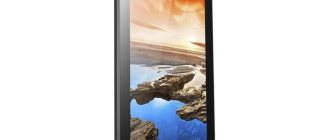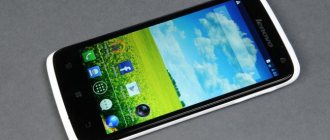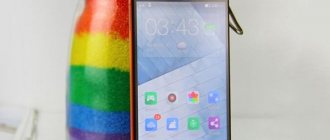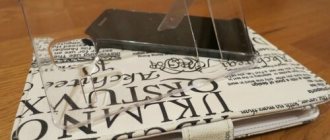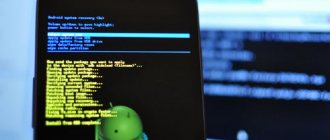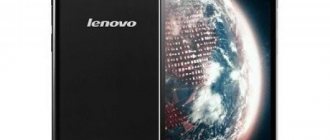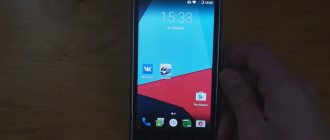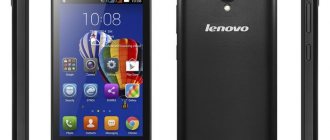Good day to all Trashbox readers. Today I got my hands on the Lenovo S860 smartphone. A distinctive feature of this device is its battery capacity, which is 4000 mAh. The number is, of course, impressive and it will be interesting how long the S860 will last in our proprietary test. But let's take things in order. So, what is the Lenovo S860?
Subscribe to our Zen
Lenovo S860 Specifications:
- Housing Materials: Aluminum with brushed metal back
- Color: titanium
- Operating system: Android 4.4.2
- Network: GSM 900/1800/1900, WCDMA 900/2100, dual SIM support
- Processor: quad-core Mediatek MT6582, 1.3 GHz
- Graphics accelerator: Mali-400MP2
- RAM: 2 GB
- Data storage memory: 16 GB
- Screen: capacitive, IPS, 5.3 inches, 1280x720 pixels
- Camera: 8 MP main with flash and autofocus, 1.6 MP front
- Additionally: Bluetooth 3.0, Wi-Fi 802.11 b/g/n, A-GPS
- Battery: non-removable with a capacity of 4000 mAh
- Dimensions: 77x149.5x10.3 mm
- Weight: 190 g
- Device price: 4500 UAH. / 12500-15000 rub.
Appearance and ease of use
Lenovo S860 is quite a big phone. Due to its size and especially its thickness, it is not very convenient to use with one hand, although the buttons themselves are located quite well. But you won’t crush it in your pocket. Plus, or rather minus, the smartphone is a bit heavy compared to all the phones I’ve held in my hands lately.
On the front side of the device, closer to the top edge, there is a speaker, and on the left side of it are all the sensors and a 1.6 MP camera.
Closer to the bottom edge there are functional buttons. The entire front part of the smartphone is covered with protective glass without an oleophobic coating. There is also an edging, or rather, on the S860 it is really high-quality and protects the smartphone, and not, as often happens, the screen protrudes above the edging.
On the left side of the device we have a slot for two microSIM cards covered with a flap.
On the right there is a lock button and a volume rocker.
At the top we see a standard 3.5mm headset jack and an additional microphone hole.
At the bottom of the edge you can see where the main microphone is located. Also on the bottom edge is a miniUSB port and speaker grilles. Although there are two grilles, it feels like there is only one speaker, albeit quite loud.
There is no way to actually see how it looks, since the phone’s cover is not removable. On this cover in the center you can see the Lenovo logo, and above it is an 8 MP camera with an LED flash.
The build is really high quality. Judging by the abundant scratches and bruises, previous reviewers decided to conduct some kind of drop test. And even after this, the phone does not boil, does not play, and works normally. At the same time, the cover has a good relief, so that scratches are actually masked against the background.
Contents of delivery
The Lenovo S860 comes in a beautifully designed white box with an image of the smartphone on it. Inside there is red cardboard with markings on where everything is. In general, the packaging is very high quality and unusual.
The delivery package also turned out to be quite good. So it includes a quick user guide, a USB cable, a SIM card ejector, a power supply, a headset and an adapter for using USB OTG. Separately, we note the proprietary, nicely designed power supply, as well as the headset with vacuum-type headphones. There are even replaceable attachments for the latter!
The USB On-The-Go adapter somewhat expands the scope of application of the S860. Typically, manufacturers do not supply smartphones with this component, which means users may simply not know all the capabilities of their phones.
Of course, for complete satisfaction, a case for the Lenovo S860 would be nice, but you will have to buy it separately. From what we saw, the price is not the lowest - around $20-30.
A more complete picture of the Lenovo S860 smartphone will allow you to make its video review:
Screen
The smartphone is equipped with a 5.3-inch capacitive IPS display with a resolution of 1280x720 pixels. The screen quality is quite good. At maximum viewing angles, colors do not fade or change shade.
The maximum brightness level seemed not enough to me, but I never managed to catch a sunny day, so I can’t say for sure. The minimum, on the contrary, I want to reduce it a little more. Automatic brightness adjustment copes with the task.
The smartphone does not have an oleophobic coating, so fingerprints will accumulate abundantly on the screen. Multi-touch works well, responds clearly and quickly, and recognizes up to five simultaneous presses.
System
Lenovo S860 runs Android 4.4.2. The system shell is not standard, as for Android smartphones in general, but quite common for Lenovo in particular. There is no “Applications Menu”, only the desktop.
In general, the system is more similar to iOS. For inexperienced users, this will be very unusual, because except for Xiaomi and Lenovo, a similar interface on Android cannot be found. There are also proprietary applications: Lenovo SHAREit, Lenovo SECUREit, Lenovo SYNCit. There are a bunch of pre-installed applications that you have to disable because they are very annoying with their notifications about nothing.
True, there is a fairly convenient standard file manager. In addition to accessing the file system, it is convenient to see how much space what types of data take up.
The settings section contains non-standard functions. For example, unlocking the screen by holding your finger over the bottom of it, or using the volume buttons. Smart call: that is, the call starts as soon as you hold the phone to your ear in the contact menu or when writing an SMS.
Autonomy
Here it is, the side of the smartphone about which I have nothing bad to say. Not only is there a 4000 mAh installed with relatively light hardware, but also the optimization is at the highest level. Lenovo Power Manager is exactly what makes me very happy about the smartphones of this company. Besides the price, of course. From phone to phone, this program becomes not only more practical and convenient, but also more beautiful. It’s very easy to monitor battery consumption, quickly optimize your smartphone, or turn it into a dialer for twenty days in one move.
If you don’t turn off the Internet on it, alternate Wi-Fi and mobile Internet, use it as a camera, workstation and communicate from both SIM cards, then it will easily last for a couple of days. If it’s more economical and you don’t hang out on the Internet for hours, then you can go away for five days. In general, I didn't carry a battery cord in my backpack, and for an Android smartphone that means something. By the way, if you connect an OTG cord to it, you can recharge less durable devices. Does your smartphone do this?
Performance
The smartphone is equipped with a quad-core MediaTek MT6582 processor with a frequency of up to 1.3 GHz per core, a Mali-400MP graphics accelerator, and 2 GB of RAM.
It is very sad that the Lenovo S860 does not support memory cards, and this despite the fact that out of the 16 GB of the phone’s declared internal memory, about 13 GB is available to the user.
The smartphone accepted the usual toys for our tests, Real Racing 3 and Dead Trigger 2, with maximum quality settings without slowdowns or lack of FPS.
Test results in various benchmarks:
- Antutu Benchmark 5.1: 18558
- Quadrant 2.1.1: 7160
- Sunsiped Chrome 1.0.2: 1584.3 ms
- Epic Citadel HQ 1.07: 47.2 fps
- Basemark ES 2.0 Taiji 1.2: 21.51 fps
- Basemark X High 1.1: 4840
- Basemark OS II 1.0.1.0: 396
Antutu and Quadrant
BaseX Mark
Terminator 3. Lenovo S860 smartphone review
The Lenovo company, which, according to IDC data, in the second quarter of this year jumped to first place in sales of smartphones in units in Ukraine (and already occupies a good position in the world), once had such a promising 5-inch smartphone with a capacious battery and metal body - P780. Later, a smaller model (4.7 inches) was released, but with the same features - the S660 (we didn’t even miss the opportunity to review it). All two devices appeared in fairly popular price and size (well, you understand what I mean, right?) categories. And then the third arrived behind them, another “terminator” with characteristics that are valuable in our latitudes - a very large display and an equally “very large” battery - S860. That's what we'll look at in this review.
What is this?
Lenovo S860 is a smartphone that the manufacturer is targeting at a business audience - those interested in the longest-lasting device with a large screen that is comfortable for reading and working with correspondence. The model may also be of interest to any non-business person with similar expectations from a smartphone.
Why is he interesting?
The most important features of the Lenovo S860 are the 4000 mAh battery and the convincingly sturdy metal body. Well, a 5.3-inch IPS display with HD resolution and excessive brightness, on which it is comfortable to work with mail and all kinds of correspondence, even “in the fields” or on the beaches.
What else does it have?
The smartphone is equipped with an entry-level quad-core Mediatek processor - MTK6582 with weaker graphics compared to MTK6589 (Mali-400MP2 versus PowerVR SGX544), but with a record 2 GB of RAM. This “filling” can well impress a technically non-savvy customer in a store, but in fact it falls to the average level and does not demonstrate miracles of performance. The Lenovo S860 is also equipped with a good 8-megapixel main camera. According to the good old CIS tradition, the smartphone is equipped with slots for two SIM cards.
How good is the case?
If we put aside the dissatisfaction with the monstrous weight and the case, which is not at all compact by modern standards (it’s not very convenient to read from a smartphone weighing 190 grams, and the gadget bulges out of your pocket), then we can only admit that it is beautiful. The non-separable (without special tools, of course) metal case of the Lenovo S860 is almost impossible to scratch, knock or cause cracks to appear. The smartphone patiently endures light falls (but the screen still needs to be protected!), contact with rough surfaces and other abuse.
And also, unlike the Lenovo S920, the S860 has all the connectors and control buttons in the intuitively correct places. The screen lock key is on the right side within easy reach, and the volume control key is above it.
MicroUSB and two speakers are on the bottom end. Therefore, it is comfortable to hold the smartphone in your hand while charging, and it is difficult to cover the speakers with your palm when the device is in your hands or lying on a table/sofa/ground. By the way, the speakers are rather weak; you won’t be able to show your favorite clip to your friends in a noisy place. And they are not suitable for listening to music.
Two microSIM connectors are hidden like a train in a slot that cannot be opened without a special paperclip. But the paperclip is included. Includes OTG cable. Some people cannot do without the latter - the smartphone does not support microSD cards with a built-in 16 GB storage.
The long ends of the device are covered with metal, but the short ends are protected by plastic. From above, this is apparently explained by the location of the communication modules, but from below, I believe, by the fact that it was easier to cut out beautiful speaker holes. The inclusions of plastic are not noticeable, and the smartphone itself looks serious, attractive, and reliable. But the hands will have to be pumped up.
Is the screen good?
The Lenovo S860 screen is its pride and pain. Pain - because it works strangely with touches. It doesn’t always work and it’s not always correct; it often confuses clicking with scrolling. Given the combination of price and performance, this nuisance can be forgiven. I do not rule out that this was a problem with our sample, which had to go through many playful hands and along the way lost almost the entire delivery set, and at the same time acquired a couple of chips on the ends.
The pride is the overwhelming maximum brightness (504.84 cd/m2), with which the display does not care about any sun, you can even play Real Racing 3 in the desert, support for working with gloves (you need to specifically enable it in the settings) and, in principle, comfortable for 5.3 inches HD -resolution (pixel density 277 ppi), which does not burden the not very powerful processor with a heavy load. But black is rather weak, only 0.94 cd/m2
| Device name | White field brightness, cd/m2 | Black field brightness, cd/m2 | Contrast |
| Lenovo S860 | 504.84 | 0.94 | 537:1 |
| Samsung Galaxy Grand 2 | 349.15 | 0.73 | 478 |
| Huawei Honor 3X G750D | 455 | 0.39 | 1137:1 |
| LG G Pro Lite | 328.28 | 0.52 | 631:1 |
| Lenovo S920 | 379.84 | 0.74 | 513:1 |
| Samsung Galaxy S5 | 370.3 | 0 | ∞ |
| HTC One M8 | 459.44 | 0.22 | 2088:1 |
| LG G2 | 336.41 | 0.4 | 840:1 |
| Samsung Galaxy Note 3 | 323.81 | 0 | ∞ |
| HTC One Max | 416.37 | 0.33 | 1262:1 |
| Huawei Ascend Mate | 454.76 | 0.58 | 791:1 |
The Lenovo S860 display is calibrated, as is often the case in mid-range devices, with the left heel. It suffers from an excessively cold color temperature (see graphs) and an abundance of blue. However, due to the fact that the graph is bad along the entire length (read - in any area of the image, both light and dark, the screen is equally blue), the picture on it looks much nicer than on the Sony Xperia Z1 Compact, which has graphs of screen measurements with a colorimeter resemble a bad cardiogram, because the blue color clogs the rest only in the dark areas of the image.
How long does the battery last?
For a long time! There are cases in history where a smartphone equipped with a battery with a capacity of more than 4000 mAh barely survived until the evening. But they are clearly not about the Lenovo S860. When you get home from work on Friday evening with a fully charged battery, you can be sure that the device will last at least until Sunday evening, and at most until Monday afternoon. Even my attempts to use the device to its fullest did not allow me to drain the battery in two days. Moderately active owners can expect four days of use on a single charge.
But there is also a downside. You should not rely on your computer to restore your battery reserves. At best, the smartphone will absorb 1-1.5% per hour and will not cope with such “feeding” overnight. At worst, if you continue to use it, it will discharge faster than it charges. In order to avoid sadness over an untimely dead battery, you should use the original charger more often and remember about the battery either at night, or at the beginning of the working day, if you spend the latter at the outlet.
Doesn't it slow down?
This happens too. Today, the quad-core MTK6582 processor installed in the Lenovo S860 is used in smartphones costing from 1,200 hryvnia. It’s strange that a smartphone for 4,000 UAH has this installed, and not its slightly more powerful predecessor MTK6589 or the noticeably more powerful eight-core successor MTK6592. In general, the interface usually moves quickly, but the work in the browser is noticeably slow, pages are slow to load, and videos are slow (although the Vellamo test gives a very cheerful result). From time to time, when the device's memory (almost all 2 GB!) becomes clogged, the interface also loses its smoothness and begins to freeze while scrolling through desktops, launching applications and exiting them. Games like Temple Run 2 and Real Racing 3 run with a comfortable amount of fps. There are no problems with films either. If you do not take into account temporary cloudings of “reason,” then usually the smartphone works at a comfortable pace. I don’t rule out that its firmware will eventually be updated to the point where “usually” will change to “always”. And yet, somewhere in the far corner of your conscience, a little worm of doubt whispers that for the same money you can buy a Samsung Galaxy Grand 2 screen that is faster and more reliable in terms of performance and reactions.
What's so interesting about the interface?
Lenovo S860 runs the latest Android 4.4.2. A feature of the Lenovo proprietary interface is (in addition to the absence of a separate menu with programs) the presence of a large number of additional applications: for protecting and synchronizing data (they cannot be deleted), a carriage of Yandex applications and other services, pre-installed clients for social networks. And this in itself is the answer to the question of why a smartphone needs 2 GB of RAM and where does it put it if the user has access to, at best, 600 MB.
The interface of this Lenovo model is no different from the previous ones. The only discovery that awaited me in the settings related to the “smart” functions - for some reason they may differ from model to model. Usually their list looks like this, as shown in the screenshots below, but some options are missing for state employees. I consider the most valuable of the “smart” options presented in the list to be the ability to track your eyes and not turn off the backlight, as well as automatically increase the volume in your pocket and decrease it in your hands. The rest will most likely be appreciated only by sophisticated technology lovers.
If you don’t have any prejudice against an interface without an application menu, then there shouldn’t be any problems interacting with the Lenovo S860. If you stuff all unnecessary applications into folders (or completely delete them), then it becomes more than comfortable for work. More information about the interface of modern Lenovo smartphones can be found here, here and here.
What about the camera?
The smartphone is equipped with an 8-megapixel camera, and this is quite typical for a device in the mid-price category. Our experienced readers probably know that eight megapixels are different from eight megapixels. As for the Lenovo S860 camera, it can be described as very good. It cannot compete with the flagship 8-megapixel modules, but it will still be much better than the “nameless” analogues. The camera copes well (as far as this concept can be applied to mobile photography) with sunsets, shooting in dimly lit rooms, in cloudy weather and with close objects. Its settings include six preset shooting modes, some (for example, the one traditionally called HDR) have strange names, but this does not prevent them from working correctly.
Examples of photographs can be found below or in a separate gallery on Torba in original resolution.
Who are the competitors?
This model does not have many competitors, but all are interesting. The only thing in which the Lenovo S860 is invincible is autonomy - there are no other devices in this segment that can last three to four days on a single charge. There are 5-inch Lenovo P780 and Philips Xenium W6610, but among the more or less “shovels” the S860 has no equal.
In my opinion, the most serious 5.3-inch competitor to this model is the Samsung Galaxy Grand 2. The smartphone has high performance, there are no problems with display sensitivity and, in general, it works more stable, without “stuck” due to clogged RAM. It also has a strong argument in the form of support for memory cards, which eliminates the crutch of an OTG cable. The price for both devices today is the same. Therefore, if it is not critical that you have to run to the outlet every two or three days, then I would recommend taking a closer look at the Grand 2.
The next interesting alternative is the Lenovo S920. This smartphone is about one and a half thousand hryvnia more interesting than the hero of the review. I believe that in the eyes of some users, 100 dollars in savings today will look more rational than half the battery life of a smartphone. What also speaks in favor of buying the Lenovo S920 is that the smartphone has no problems with the display processing touches (however, its screen does not support operation with gloves) and user-accessible RAM. And its quad-core MTK6589 processor has slightly more powerful graphics. Although the difference here is not that big. More information about the model can be found in its review.
Finally, another interesting competitor to the Lenovo S860 is the Huawei Ascend G750D (aka Honor 3X). The smartphone has an excellent quality 5.5-inch IPS display, high performance, less weight and thickness. Although this model costs several hundred hryvnia more and has a smaller battery (3000 mAh versus 4000 mAh), and cannot boast of a metal case, we generally liked it for its neatness, compactness, and fast and stable operation (you can read more about everything in the review). However, in terms of autonomy, the smartphone is not so far behind the S860.
Bottom line
For those who need a smartphone with a large display and uncompromising battery life, the Lenovo S860 is a direct choice. Along this straight path you will have to stumble over the sensitivity of the screen and the slowness of the browser, but if you look at the price of the device in dollars (about $300), then questions regarding minor flaws disappear by themselves. The two closest competitors of the model (Samsung Galaxy Grand 2 and Lenovo S920) were lucky to enter the best times for the domestic currency and maintain the same adequate price tag by the end of summer. That is why, for the same or even significantly less money, they are ready to boast of higher performance and better stability. But none of them come close to the hero of this review in terms of battery life or, for example, such parameters as display brightness and the ability to work with gloves. If you are ready to put up with the shortcomings voiced at the very beginning of this paragraph, for the sake of the opportunity not to worry about the daily availability of an outlet at hand or weather conditions, then you can opt for this third “Terminator” from the Lenovo smartphone line. But if the battery is not your main concern, I recommend looking at alternatives.
3 reasons to buy Lenovo S860:
- excellent autonomy;
- large and bright display with the ability to work with gloves;
- durable metal case;
3 reasons not to buy Lenovo S860:
- The screen responds strangely to touches;
- heavy weight - as much as 190 g!
- periodic interface slowdowns (one could not complain about this, but its closest competitors do not suffer from this).
| Lenovo S860 Specifications | |
| operating system | Android 4.4.2 |
| SIM card | two, microSIM |
| Display | IPS, 5.3 inches, 1280x720 pixels (HD), 277 ppi, support for working with gloves |
| Frame | dimensions 150x77x10 mm, 190 g |
| CPU | MediaTek MT6582, 4 cores ARM Cortex-A7, clock frequency 1.3 GHz; video accelerator Mali-400MP2 |
| RAM | 2 GB |
| Flash memory | 16 GB, no memory card support, but an OTG cable for connecting flash drives included |
| Camera | 8 MP, autofocus, 1080p video recording, flash, HDR mode, 2 MP front camera |
| Wireless technologies | Wi-Fi a/b/g/n, Bluetooth 3.0 |
| GPS | Yes |
| Battery | 4000 mAh |
Camera
Lenovo S860 is equipped with an 8 MP main camera with autofocus and flash and a 1.6 MP front camera.
The quality of the main camera generally leaves a good impression. The flash is clearly blue, but the macro photography is very good. The front camera will also cope with its tasks quite well.
Example photo from the main camera:
Example photo from the front camera:
Communications and sensors
Lenovo S860 supports GSM and 3G networks. Naturally, there is only one radio module, so only one card works in active mode.
Mobile network - the smartphone operates in 2G (GSM/GPRS/EDGE, 900/1800/1900 MHz) and 3G (WCDMA, 900/2100 MHz) cellular networks. The device supports working with two SIM cards; during calls on one, the second one becomes inaccessible.
Wi-Fi (b/g/n) - in the settings you can enable the “distribution” of mobile Internet using Wi-Fi, and also use file transfer using Wi-Fi Direct. Bluetooth 4.0 – all popular profiles are supported, including A2DP.
There are no complaints about the operation of the Wi-Fi and Bluetooth 4.0 modules.
Equipment
The smartphone is delivered in a white cardboard box. Inside, in addition to the smartphone, you can find a USB cable, a 2A network charger, an OTG cable, a clip for changing SIM cards and a headset. This set can be safely called very good.

